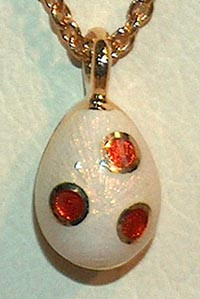The Eggs of Faberge
The concept of a decorative jeweled egg has become virtually synonymous with the name Faberge. The celebrated egg-charms, Peter Carl Faberge's most popular creations, were passionately collected by the ladies of high society. Such pendants were proudly added to chains of ever-growing length each Easter. Their fame resides not only in the exclusive clientele for which they were destined, but also in their exquisite beauty. In essence such eggs symbolize life, rebirth, and love. As such they can convey a coded, intimate, and loving message. Today, too, the fascination with these objects of art also lies in their stylistic diversity, in their manifold materials, their technical perfection, and in the whimsical surprises they sometimes contain. The special technique behind the shimmering guilloché enamel surface of a genuine Faberge egg is a trade secret. However, the basic technique of Guilloché enamelling requires an engraved design on the gold covered with several layers of translucent enamel (glass paste) with each layer being fired at a very high temperature. Contemporary Faberge fine jewelry items generally have seven layers of hot enamel - six colored and one final clear top coat.

Faberge pendants from the late 19th century.

Faberge Imperial "Hen Egg" - 1885
The most famous Faberge creations were the 50 Imperial Easter eggs designed and created for Tsars Alexander III and Nicholas II as gifts to be given to their mothers and wives. The very first Imperial egg was the "Hen Egg" produced in 1885 by workmaster Erik Kollin. The egg was a gift from Tsar Alexander III to his wife, Maria Fedorovna. The outer shell of the egg is coated with a white enamel. Inside is a golden yolk containing a small gold hen. Inside the hen was a diamond replica of the Imperial crown and a small ruby Easter egg, both of which have since disappeared.
Most of the original Imperial Easter eggs are now back in Russia. Some are on exhibit in the Kremlin Armoury Museum in Moscow and others are on loan to various museums throughout the world. Only a very few are in private collections today although there are approximately four that have "disappeared."
Other items produced in the original workshops of Peter Carl Faberge are scattered throughout the world in museums and private collections. However, most of the antique "Faberge" items that come on the market via the Internet and unscrupulous or uneducated antique dealers are not genuine Faberge. It is estimated that at least 75% of "Faberge" items offered for sale today and represented as being genuine antique Faberge are in fact fakes. They are either antique works from other jewelers workshops that have been given a fake "Faberge" hallmark, or they are modern reproductions by illegitimate makers. It has also become common for people to call any type of decorated egg "Faberge."
The Faberge Company does still exist. There are two branches of contemporary authentic Faberge - Faberge Fine Jewelry by Victor Mayer and Faberge Gifts in association of Tatiana Faberge (the great granddaughter of Peter Carl Faberge.)

